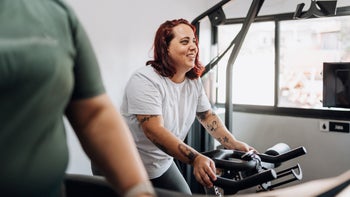
7 Proven Health Benefits of Jumping Jacks
Key takeaways:
Jumping jacks offer full-body exercise, working muscles in your arms, legs, and core.
The exercise can strengthen muscles, improve coordination, and boost fitness.
You can add traditional jumping jacks to your workouts. Or try variations — like step jacks or squat jacks — based on your fitness level.
Table of contents

Jumping jacks are more than a classic activity from your elementary school P.E. classes. The dynamic move gets your heart pumping and your muscles working. That makes it an excellent choice for warm-ups, cardio, and strength-training workouts. Plus, jumping jacks offer health benefits to help you reach your fitness goals.
What are the benefits of jumping jacks?
Jumping jacks are a staple for many people, from beginners to fitness pros. They’re an efficient total-body move you can do almost anywhere. These top benefits of jumping jacks will make you want to add them to your workout routine.
1. Jumping jacks provide full-body exercise
Try jumping jacks if you’re short on time but need a full-body workout. The tried-and-true exercise works your legs as you jump and land on your feet. But it also activates upper-body muscles as you swing your arms.
Search and compare options
The compound movement recruits multiple muscle groups, including the:
Deltoids
Abdominals
Hip flexors
Glutes
Quadriceps
Hamstrings
2. Jumping jacks promote cardiovascular fitness
When it comes to aerobic exercise, jumping jacks are a fantastic choice. Rhythmic jumps and arm swings elevate your breathing and heart rate and increase blood circulation. Your heart, lungs, and muscles work harder to keep your body moving.
Adding jumping jacks to regular cardio workouts can strengthen your heart and improve cardiovascular fitness (VO₂ max).
Bonus points if you add high-intensity interval training (HIIT). HIIT involves switching between vigorous exercise intervals and lower-intensity recovery periods. You can alternate jumping jacks with a lower-intensity exercise to create a HIIT regimen.
A small-scale study analyzed aerobic resistance training in active young women. They did HIIT workouts with total-body exercises, including jumping jacks. After 4 weeks, they had better aerobic fitness and more muscle endurance. This type of endurance helps your muscles exert force against resistance. That means you can do more reps without stopping.
Warm up with more cardio exercises. Get your body moving with these warm-up exercises.
Jumping rope vs. running: Find out which high-impact exercise is better.
Try plyometrics to build muscle power and endurance. These exercises involve quick, explosive moves to keep your muscles guessing.
3. Jumping jacks boost muscle strength and power
Jumping jacks do double duty as a cardio and strength-building activity. The exercise involves rapid movement that engages large muscle groups, especially in your lower body. Jumping jacks mainly target the:
Glutes
Hip flexors
Quads
Calves
So you can build leg muscle strength, power, and endurance with jumping jacks and other plyometric exercises.
Read more like this
Explore these related articles, suggested for readers like you.
4. Jumping jacks support strong bones
Maintaining strong bones is especially important as we age. Resistance and weight-bearing activities help you do just that. And jumping jacks fall into both categories.
Jumping jacks are a strengthening exercise because you use your body weight as resistance. They’re a weight-bearing exercise because you work against gravity while standing. After each jump, you land on your feet. The impact may increase bone density and strength.
Jumping exercises have been shown to boost bone density in premenopausal women and men with low bone density. These and other resistance and weight-bearing exercises promote long-term bone health. And strong bones can lower the risk of osteoporosis, falls, and fractures.
5. Jumping jacks enhance balance and coordination
Consider jumping jacks an exercise in multitasking. Simultaneous jumping and arm swinging require balance, rhythm, and coordination. You can put these skills to the test by regularly practicing jumping jacks.
One review found that plyometric jump training may enhance static and dynamic balance in beginner and experienced athletes.
But you don’t have to be an athlete to sharpen your balance and coordination skills. Another review found that regular physical activity, including jumping and body-weight exercises, may improve balance, strength, and endurance in adults ages 40 to 65.
6. Jumping jacks improve functional and athletic performance
Jumping jacks offer so many potential health and fitness improvements. So it’s not surprising that jump training may also improve functional and athletic performance.
Researchers tested a modified plyometric training program in older men in one study. The program included increasingly difficult skipping, hopping, and jumping exercises. After 12 weeks, the men had improved muscle power, strength, and functional fitness.
Plyometric training has also been shown to improve athletic performance, including jump height and sprint performance. One study found that jump training increased physical fitness and performance in endurance runners.
7. Jumping jacks are convenient and accessible
One of the best things about jumping jacks is that they’re convenient and accessible. You can do them almost anywhere, whether at home, in the park, or at the gym. And even if it’s been a long time, you’ve probably done them before at some point.
The exercise doesn’t require special equipment or ample space. So jumping jacks are ideal for those with limited time or resources. You can easily add them to various workouts and modify them to suit your fitness level.
How to do jumping jacks
Proper form is key to enjoy the benefits of jumping jacks and stay injury-free.
Here’s a quick recap on how to do jumping jacks, even if you’ve done them many times:
Step 1: Stand tall with your feet shoulder-width apart and arms by your sides.
Step 2: Bend your knees and jump up, moving your legs out to your sides and raising your arms out and overhead.
Step 3: Jump back to the starting position, bringing your feet together and lowering your arms to your sides.
Step 4: Try to land lightly, keeping a slight bend in your knees.
Step 5: Repeat the movement, maintaining a steady rhythm.
Step 6: Aim for 1 to 2 sets of 10 reps if you’re a beginner.
Types of jumping jacks
There are several types of jumping jacks, including:
Cross jacks
High-knee jacks
Split squat jacks
Hop jacks
Plank jacks
Here’s an example of a beginner-friendly and advanced jumping jack modification to give you an idea of the range of difficulty.
Step jacks
Beginners and those who need to avoid high-impact jumping exercises can try the step jack.
Step 1: Stand tall with your feet shoulder-width apart and arms by your sides.
Step 2: Raise both arms out and overhead as you quickly step your right foot out to the side.
Step 3: Lower your arms as you step your right foot back to the center.
Step 4: Repeat the movement, stepping out and back in with your left foot. That’s one rep.
Step 5: Do 2 sets of 10 reps, keeping a quick, steady pace.
Squat jacks
Advanced moves like squat jacks can take your jumping jack routine to the next level. This variation combines the benefits of squats — like increased core strength — and jumping jacks in one move.
Step 1: Start in a slight squat with your feet together, knees bent, and arms clasped in front of your chest.
Step 2: Jump your feet out to the sides, landing in a wide squat. Make sure your knees don’t extend beyond your toes when you land. You can squat further down and swing your arms overhead for more of a challenge.
Step 3: Reverse the movement, jumping your feet back to the starting position.
Step 4: Do 1 to 2 sets of 10 reps quickly and with control.
Frequently asked questions
Yes, jumping jacks can help tone your body. The full-body exercise may target and strengthen multiple muscle groups, including the hip flexors, glutes, quads, and calves.
Contrary to popular belief, you can’t target fat loss in a specific area. But doing jumping jacks burns calories, which may help you lose weight when combined with other regular exercises and a balanced diet.
Not necessarily. Jumping jacks and running can build endurance and boost your fitness. So the best choice depends on your fitness level, goals, and preferences. For example, running may burn more calories, but jumping jacks may be more convenient when you’re short on time. You can also include both exercises in your fitness routine.
The bottom line
With all the incredible benefits of jumping jacks, it’s time to unlock their potential and include them in your fitness routine. You can add the explosive move to your warm-ups, cardio, or resistance workouts. Beginner-friendly and advanced modifications mean people of different fitness levels can reap benefits like stronger muscles and better aerobic fitness.
Why trust our experts?



References
Baharuddin, M. Y., et al. (2017). Biomechanics analysis on muscle activation during jumping jack exercise. Journal of Sports Science and Physical Education.
Biohacking Bombshell with Allyssa LaScala. (2018). Leg exercises: Squat jacks [video].
Clissold, T. L., et al. (2022). The chronic effects of a quantified jump-landing program on bone health, body composition and performance parameters in premenopausal women. Journal of Family Medicine.
DAREBEE. (2015). Exercise library: Step jacks [video].
Ferreria, M. L., et al. (2012). Physical activity improves strength, balance and endurance in adults aged 40–65 years: A systematic review. Journal of Physiotherapy.
Grgic, J., et al. (2021). Effects of plyometric vs. resistance training on skeletal muscle hypertrophy: A review. Journal of Sport and Health Science.
Hinton, P. S., et al. (2015). Effectiveness of resistance training or jumping-exercise to increase bone mineral density in men with low bone mass: A 12-month randomized, clinical trial. Bone.
Hong, A. R., et al. (2018). Effects of resistance exercise on bone health. Endocrinology and Metabolism.
McRae, G., et al. (2012). Extremely low volume, whole-body aerobic–resistance training improves aerobic fitness and muscular endurance in females. Applied Physiology, Nutrition, and Metabolism.
National Institute of Arthritis and Musculoskeletal and Skin Diseases. (2023). Exercise for your bone health.
Oxfeldt, M., et al. (2019). Effects of plyometric training on jumping, sprint performance, and lower body muscle strength in healthy adults: A systematic review and meta-analyses. Scandinavian Journal of Medicine & Science in Sports.
Ramachandran, A. K., et al. (2021). Effects of plyometric jump training on balance performance in healthy participants: A systematic review with meta-analysis. Frontiers in Physiology.
Ramirez-Campillo, R., et al. (2021). Effects of jump training on physical fitness and athletic performance in endurance runners: A meta-analysis. Journal of Sports Sciences.
Redefining Strength. (2015). 20 jumping jack variations [video].
Van Roie, E., et al. (2020). An age-adapted plyometric exercise program improves dynamic strength, jump performance and functional capacity in older men either similarly or more than traditional resistance training. PLoS One.



























